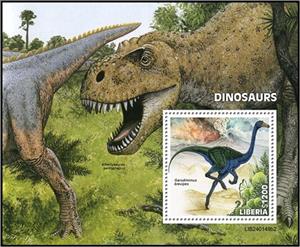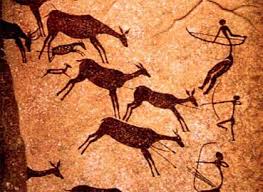Souvenir Sheet: Garudimimus brevipes (Liberia 2024)
Garudimimus brevipes (Liberia 2024)
05 January (Liberia ) within release Dinosaurs (2024) goes into circulation Souvenir Sheet Garudimimus brevipes face value 1,200 Liberian dollar
| Souvenir Sheet Garudimimus brevipes in catalogues | |
|---|---|
| Colnect codes: | Col: LR 2024.01.05-124 |
Souvenir Sheet is square format.
Also in the issue Dinosaurs (2024):
- Se-tenant - Altispinax dunkeri face value 4*200;
- Souvenir Sheet - Altispinax dunkeri face value 720;
- Mini Sheet - Dinosaurs face value 4*300;
- Souvenir Sheet - Garudimimus brevipes face value 1,200;
- Se-tenant - Pachycephalosaurus wyomingensis face value 4*200;
- Souvenir Sheet - Pachycephalosaurus wyomingensis face value 720;
- Se-tenant - Protoceratops andrewsi face value 4*200;
- Souvenir Sheet - Protoceratops andrewsi face value 720;
- Souvenir Sheet - Sinornithoides youngi face value 1,200;
- Se-tenant - Sinosauropteryx prima face value 4*200;
- Souvenir Sheet - Sinosauropteryx prima face value 720;
Souvenir Sheet Garudimimus brevipes it reflects the thematic directions:
Animals are multicellular, eukaryotic organisms of the kingdom Animalia (also called Metazoa). All animals are motile, meaning they can move spontaneously and independently, at some point in their lives. Their body plan eventually becomes fixed as they develop, although some undergo a process of metamorphosis later on in their lives. All animals are heterotrophs: they must ingest other organisms or their products for sustenance.
Dinosaurs are a diverse group of reptiles of the clade Dinosauria. They first appeared during the Triassic period, between 243 and 233.23 million years ago (mya), although the exact origin and timing of the evolution of dinosaurs is a subject of active research. They became the dominant terrestrial vertebrates after the Triassic–Jurassic extinction event 201.3 mya and their dominance continued throughout the Jurassic and Cretaceous periods. The fossil record shows that birds are feathered dinosaurs, having evolved from earlier theropods during the Late Jurassic epoch, and are the only dinosaur lineage known to have survived the Cretaceous–Paleogene extinction event approximately 66 mya. Dinosaurs can therefore be divided into avian dinosaurs—birds—and the extinct non-avian dinosaurs, which are all dinosaurs other than birds.
Prehistory, also called pre-literary history, is the period of human history between the first known use of stone tools by hominins c. 3.3 million years ago and the beginning of recorded history with the invention of writing systems. The use of symbols, marks, and images appears very early among humans, but the earliest known writing systems appeared c. 5,200 years ago. It took thousands of years for writing systems to be widely adopted, with writing spreading to almost all cultures by the 19th century. The end of prehistory therefore came at different times in different places, and the term is less often used in discussing societies where prehistory ended relatively recently.
Reptiles are tetrapod (four-limbed vertebrate) animals in the class Reptilia, comprising today's turtles, crocodilians, snakes, amphisbaenians, lizards, tuatara, and their extinct relatives. The study of these traditional reptile orders, historically combined with that of modern amphibians, is called herpetology. Because some reptiles are more closely related to birds than they are to other reptiles (e.g., crocodiles are more closely related to birds than they are to lizards), the traditional groups of "reptiles" listed above do not together constitute a monophyletic grouping (or clade). For this reason, many modern scientists prefer to consider the birds part of Reptilia as well, thereby making Reptilia a monophyletic class.




